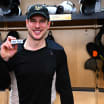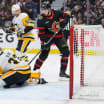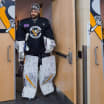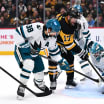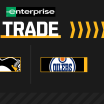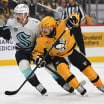The Penguins are in the process of talking to their players about wearing protective equipment in vulnerable areas after former teammate Adam Johnson tragically lost his life in a terrible accident on the ice while playing for the Nottingham Panthers of England’s Elite Ice Hockey League.
Both of Pittsburgh’s minor-league teams – Wilkes-Barre/Scranton of the American Hockey League and Wheeling of the ECHL – have mandated neck guards, along with wrist guards, for their players.
“We can't do that at the NHL level, but we can certainly strongly encourage, and that's our hope,” Penguins Head Coach Mike Sullivan said. “Hopefully, as a league, we can work towards developing more options for guys in the protective department. Hopefully, there will be an initiative here moving forward - I think that could be one of the positive things that could come out of this terrible tragedy.”
On Thursday, the Penguins equipment staff had neck guards available for anyone who wanted to try them out, and Erik Karlsson, Lars Eller, Marcus Pettersson, and Ryan Graves all wore them during practice.
“The magnitude of the situation that unfortunately happened puts a lot of things in perspective,” Karlsson said. “We do this because we love to do this and we get paid well to do it and stuff like that. But at the end of the day, we do it because it’s a choice - I don’t think anyone would keep doing it if it meant risking your life every day going out there.
“If you can wear a small piece of equipment to hopefully prevent something like that again, I think that’s a win… I’ll probably try it out for a bit and see if I can get accustomed to it, and go from there.”
It’s not an unfamiliar piece of equipment, as Karlsson had to wear one when he played in Sweden’s top professional league, and the majority of players had them growing up playing youth hockey. But as it’s been years since those days, Graves said putting it back on definitely took a little bit of getting used to, as this design is different. It’s made of thinner material, and comes up on the sides to protect the carotid arteries.
“You're a little warmer and things like that, but comparing what could happen versus wearing that, it's a pretty small detail,” Graves said. “So, it's a work in progress. I think that guys will start experimenting with them. You wear it all through minor hockey. If you look back like 15 years ago, no one wore visors. I would never play without one now. So maybe this will be part of it, and it'll become something that's second nature to us.”
Graves has a big scar on his chin after getting clipped with a skate up high two years ago. At the time, he said it didn’t cross his mind to wear more protection. But between what happened to Johnson and the overall pace of play, Graves is reconsidering his options.
“It's a fast game. It's getting faster every year that it goes on,” Graves said. “You trust that guys can control their bodies, and you don’t want skates to get that high, but it happens. It’s scary what happens, you know? Everyone's had close calls.”
And not just up high. Many players already wear the wrist guards, with Graves saying he doesn’t even notice them anymore.
“I got cut on the wrist one time when I played back home, so ever since that, I’ve been wearing them,” Pettersson said. “I wear socks, too.”
So does Karlsson, who needed surgery when his Achilles tendon got cut by a skate blade in a game against the Penguins back in 2013. In fact, that injury was most likely what inspired guys to start wearing the Kevlar socks.
“Because I don’t think really anyone was wearing it before that, and then after that I think most guys now just wear it,” Karlsson said. “It is just like a normal sock anyways, I think they have done a good job with it.”
Time will tell if the same will be said for the neck guards.
“Obviously with what just happened, I think everyone’s trying to do their best to avoid that. I think everyone’s going to take a good look at it,” Sidney Crosby said.







